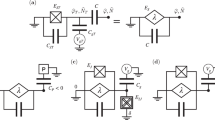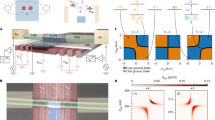Abstract
The synthesis of a quantum computer remains an ongoing challenge in modern physics. Whereas decoherence stymies most approaches, topological quantum computation schemes evade decoherence at the hardware level by storing quantum information non-locally. Here we establish that a key operation—braiding of non-Abelian anyons—can be implemented using one-dimensional semiconducting wires. Such wires can be driven into a topological phase supporting long-sought particles known as Majorana fermions that can encode topological qubits. We show that in wire networks, Majorana fermions can be meaningfully braided by simply adjusting gate voltages, and that they exhibit non-Abelian statistics like vortices in a p+i p superconductor. We propose experimental set-ups that enable probing of the Majorana fusion rules and the efficient exchange of arbitrary numbers of Majorana fermions. This work should open a new direction in topological quantum computation that benefits from physical transparency and experimental feasibility.
This is a preview of subscription content, access via your institution
Access options
Subscribe to this journal
Receive 12 print issues and online access
$209.00 per year
only $17.42 per issue
Buy this article
- Purchase on Springer Link
- Instant access to full article PDF
Prices may be subject to local taxes which are calculated during checkout




Similar content being viewed by others
References
Kitaev, A. Fault-tolerant quantum computation by anyons. Ann. Phys. 303, 2–30 (2003).
Freedman, M. H. P/NP, and the quantum field computer. Proc. Natl Acad. Sci. USA 95, 98–101 (1998).
Freedman, M. H., Kitaev, A., Larsen, M. J. & Wang, Z. Topological quantum computation. Bull. Am. Math. Soc. 40, 31–38 (2003).
Das Sarma, S., Freedman, M. & Nayak, C. Topologically protected qubits from a possible non-Abelian fractional quantum Hall state. Phys. Rev. Lett. 94, 166802 (2005).
Bonderson, P., Freedman, M. & Nayak, C. Measurement-only topological quantum computation. Phys. Rev. Lett. 101, 010501 (2008).
Nayak, C., Simon, S. H., Stern, A., Freedman, M. & Das Sarma, S. Non-Abelian anyons and topological quantum computation. Rev. Mod. Phys. 80, 1083–1159 (2008).
Leinaas, J. M. & Myrheim, J. On the theory of identical particles. Nuovo Cimento Soc. Ital. Fis. B 37B, 1–23 (1977).
Fredenhagen, K., Rehren, K. H. & Schroer, B. Superselection sectors with braid group statistics and exchange algebras. Commun. Math. Phys. 125, 201–226 (1989).
Fröhlich, J. & Gabbiani, F. Braid statistics in local quantum theory. Rev. Math. Phys. 2, 251–353 (1990).
Read, N. & Green, D. Paired states of fermions in two dimensions with breaking of parity and time-reversal symmetries and the fractional quantum Hall effect. Phys. Rev. B 61, 10267–10297 (2000).
Ivanov, D. A. Non-Abelian statistics of half-quantum vortices in p-wave superconductors. Phys. Rev. Lett. 86, 268–271 (2001).
Moore, G. & Read, N. Nonabelions in the fractional quantum Hall effect. Nucl. Phys. B 360, 362–396 (1991).
Fu, L. & Kane, C. L. Superconducting proximity effect and Majorana fermions at the surface of a topological insulator. Phys. Rev. Lett. 100, 096407 (2008).
Linder, J., Tanaka, Y., Yokoyama, T., Sudbø, A. & Nagaosa, N. Unconventional superconductivity on a topological insulator. Phys. Rev. Lett. 104, 067001 (2010).
Sau, J. D., Lutchyn, R. M., Tewari, S. & Das Sarma, S. Generic new platform for topological quantum computation using semiconductor heterostructures. Phys. Rev. Lett. 104, 040502 (2010).
Alicea, J. Majorana fermions in a tunable semiconductor device. Phys. Rev. B 81, 125318 (2010).
Sato, M. & Fujimoto, S. Topological phases of noncentrosymmetric superconductors: Edge states, Majorana fermions, and non-Abelian statistics. Phys. Rev. B 79, 094504 (2009).
Lee, P. A. Proposal for creating a spin-polarized p x+ip y state and Majorana fermions. Preprint at http://arxiv.org/abs/0907.2681 (2009).
Ghosh, P., Sau, J. D., Tewari, S. & Das Sarma, S. Non-Abelian topological order in noncentrosymmetric superconductors with broken time-reversal symmetry. Phys. Rev. B 82, 184525 (2010).
Qi, X-L., Hughes, T. L. & Zhang, S-C. Chiral topological superconductor from the quantum Hall state. Phys. Rev. B 82, 184516 (2010).
Lutchyn, R. M., Sau, J. D. & Das Sarma, S. Majorana fermions and a topological phase transition in semiconductor–superconductor heterostructures. Phys. Rev. Lett. 105, 077001 (2010).
Oreg, Y., Refael, G. & von Oppen, F. Helical liquids and Majorana bound states in quantum wires. Phys. Rev. Lett. 105, 177002 (2010).
Kitaev, A. Y. Unpaired Majorana fermions in quantum wires. Phys.-Usp. 44, 131–136 (2001).
Wimmer, M., Akhmerov, A. R., Medvedyeva, M. V., Tworzydło, J. & Beenakker, C. W. J. Majorana bound states without vortices in topological superconductors with electrostatic defects. Phys. Rev. Lett. 105, 046803 (2010).
Fu, L. & Kane, C. L. Josephson current and noise at a superconductor/quantum-spin-Hall-insulator/superconductor junction. Phys. Rev. B 79, 161408(R) (2009).
Hassler, F., Akhmerov, A. R., Hou, C-Y. & Beenakker, C. W. J. Anyonic interferometry without anyons: How a flux qubit can read out a topological qubit. New J. Phys. 12, 125002 (2010).
Bravyi, S. & Kitaev, A. Universal quantum computation with ideal Clifford gates and noisy ancillas. Phys. Rev. A 71, 022316 (2005).
Freedman, M., Nayak, C. & Walker, K. Towards universal topological quantum computation in the ν=5/2 fractional quantum Hall state. Phys. Rev. B 73, 245307 (2006).
Bonderson, P., Das Sarma, S., Freedman, M. & Nayak, C. A blueprint for a topologically fault-tolerant quantum computer. Preprint at http://arxiv.org/abs/1003.2856 (2010).
Bonderson, P., Clarke, D. J., Nayak, C. & Shtengel, K. Implementing arbitrary phase gates with Ising anyons. Phys. Rev. Lett. 104, 180505 (2010).
Dresselhaus, G. Spin–orbit coupling effects in zinc blende structures. Phys. Rev. 100, 580–586 (1955).
Bychkov, Y. A. & Rashba, E. I. Oscillatory effects and the magnetic susceptibility of carriers in inversion layers. J. Phys. C 17, 6039–6045 (1984).
Winkler, R. Spin–Orbit Coupling Effects in Two-Dimensional Electron and Hole Systems (Springer, 2003).
Stern, A., von Oppen, F. & Mariani, E. Geometric phases and quantum entanglement as building blocks for non-Abelian quasiparticle statistics. Phys. Rev. B 70, 205338 (2004).
Doh, Y-J., van Dam, J. A., Roest, A. L., Bakkers, E. P. A. M., Kouwenhoven, L. P. & De Franceschi, S. Tunable supercurrent through semiconductor nanowires. Science 309, 272–275 (2005).
Acknowledgements
We have benefited greatly from stimulating conversations with P. Bonderson, S. Das Sarma, L. Fidkowski, E. Henriksen, A. Kitaev, P. Lee, X. Qi and A. Stern. We also gratefully acknowledge support from the Lee A. DuBridge Foundation, ISF, BSF, DIP and SPP 1285 grants, Packard and Sloan fellowships, the Institute for Quantum Information under NSF grants PHY-0456720 and PHY-0803371, and the National Science Foundation through grant DMR-0529399.
Author information
Authors and Affiliations
Contributions
All authors contributed to the inception of the ideas in the manuscript, design of networks and proposed experimental setups, and proof of non-Abelian statistics.
Corresponding author
Ethics declarations
Competing interests
The authors declare no competing financial interests.
Supplementary information
Supplementary Information
Supplementary Information (PDF 2465 kb)
Rights and permissions
About this article
Cite this article
Alicea, J., Oreg, Y., Refael, G. et al. Non-Abelian statistics and topological quantum information processing in 1D wire networks. Nature Phys 7, 412–417 (2011). https://doi.org/10.1038/nphys1915
Received:
Accepted:
Published:
Issue Date:
DOI: https://doi.org/10.1038/nphys1915
This article is cited by
-
Hosohedral nodal-line superconductivity in hexagonal ABC Dirac semimetals
Communications Physics (2024)
-
Quantum Information Transmission with Topological Edge States
Journal of Low Temperature Physics (2024)
-
Superconducting tunnel junctions with layered superconductors
Quantum Frontiers (2024)
-
Broad and colossal edge supercurrent in Dirac semimetal Cd3As2 Josephson junctions
Nature Communications (2023)
-
Triplet correlations in Cooper pair splitters realized in a two-dimensional electron gas
Nature Communications (2023)



